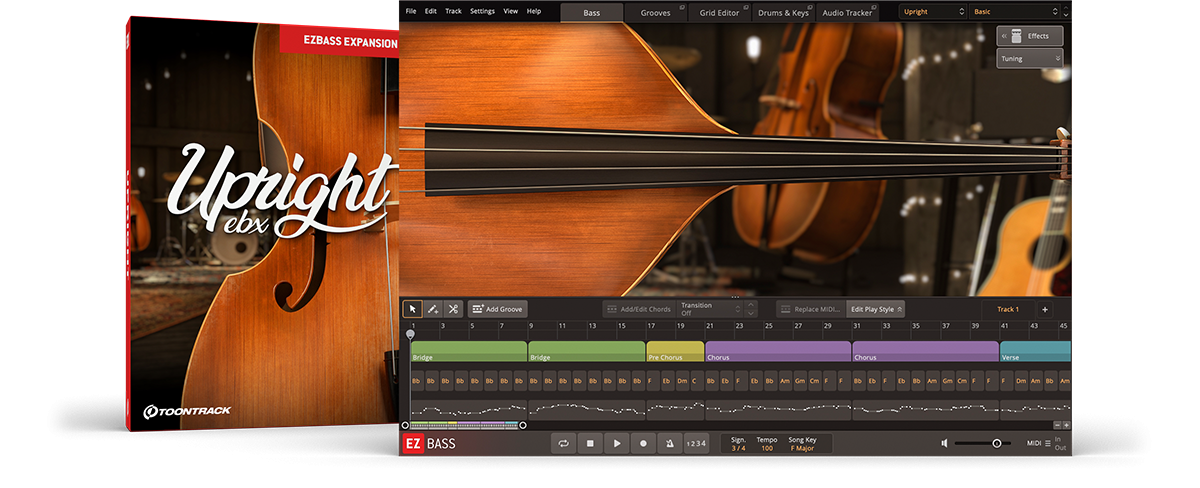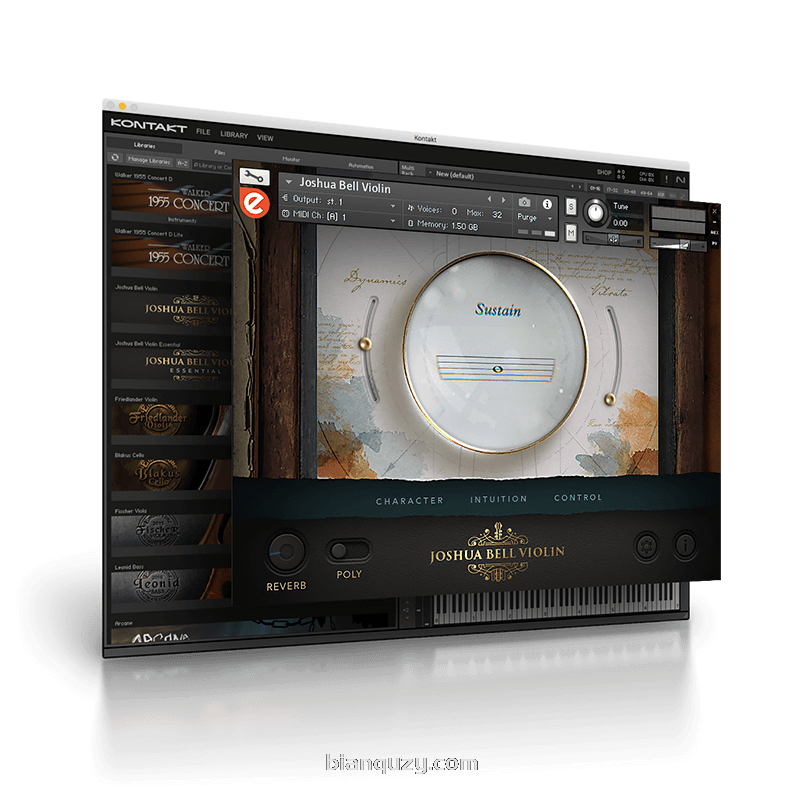 Toontrack Upright EBX v1.0.0 (SOUNDBANK)| 577.9 MB
Toontrack Upright EBX v1.0.0 (SOUNDBANK)| 577.9 MB
标志性的立式贝司。欢迎来到永恒音调的定义。低音提琴、立式低音、低音提琴、低音提琴、大提琴,或者像我们这样的立式低音。尽管它有很多名字,但它是几乎不需要一个的乐器之一——你可以通过敲击音符来区分它。从几百年前的第一次迭代到今天,立式贝斯略微低沉但仍然充满活力的共鸣、朴实和黑暗的音色已经渗透到我们音乐史上的每一层。老实说,只有一个词有足够的分量来描述它在我们所知的音乐中无可争议的作用:永恒。
Upright EBX 带有精心挑选的原声立式贝司,采样以捕捉这种经典乐器复杂而独特的特点。除了声音之外,它还包括广泛的预设选择以及 MIDI 低音线的自定义内容。
从卷轴到尾钉的尺寸为 6 英尺,但其音色就像十层楼的建筑,这是一种理想乐器的体现,适用于任何爵士、摇滚、流行或一般原声音乐作品,其中低音被“弹奏”并需要切入。欢迎来到所有贝司之母——双倍大小,双倍动作,如果您问我们,这是一种彻头彻尾的愉悦。
特色亮点
•精心捕捉原声直立低音
•使用板载压电拾音器和五种不同的麦克风配置录制
•包括一系列预设,涵盖各种流派、风格和麦克风混合的广泛音调。
•带有为乐器和无品/立式演奏风格量身定制的自定义 MIDI 库
。
完美的投影。
对于任何原声乐器,尤其是在低频范围内占主导地位的乐器,投影是关键。坦率地说,一个好的乐器需要一个唱歌和切入的声音。Corsini Elite* 由著名的罗马尼亚乐器制琴师 Calin Wultur* 生产,证明完全具备所有这些品质,是 Upright EBX 的完美搭档。
“因为我们追求现代和’原声’方法而不是古典的拨弦音色和低音,所以平背似乎是合乎逻辑的第一步。然而,立柱音色的质量是其所有部件组合的产物——从机头到尾管——而 Corsini 的声音和感觉却是彻头彻尾的,”EZbass 首席研发技术员 Magnus Melkersson 评论道。
有很多名字的低音。
低音提琴的简史。
尽管它的起源有争议,但大多数人认为直立贝斯源于 viola de gamba——一个 15 世纪的弓弦乐器家族,不要与更年轻的中提琴混淆。这个名字在意大利语中的字面意思是“腿部的小提琴”,因此可以假设其意图是一种类似小提琴的乐器,可以在腿上演奏,而不是在下巴下演奏。
最早的插图可以追溯到 1516 年,但书面记录表明甚至更早的实例。虽然该乐器的现代迭代几乎只有四根琴弦,但早期的乐器可能多达六根。记录还表明,在采用经典 EADG 方法之前,有多达 50 种不同的调音在使用,直到 20 世纪初。
总结:从逻辑上讲,低音提琴应该与单低音提琴对应——但事实并非如此。这个名字反而强调了这样一个事实,即它的音调听起来比中间 C 低两个八度。但即使是这样也有待商榷。有些人声称,“双重”只是巩固了一个事实,即它的目的是在管弦乐队中将大提琴加倍。不过,这也有待讨论。
无论什么样的,我们叫它,它最初来自或任何其他可能为辩论,任何音乐爱好者可能会证明这样一个事实,这与许多名称标志性的低音已经铭刻在音乐的不可否认的印记,因为我们
的声音-关节。
鉴于此贝斯主要用于爵士、摇滚、流行或一般原声音乐作品,因此仅使用拨弦(拨弦)技术对其进行采样。为了提供尽可能广泛的音调选择,板载压电拾音器和五个不同位置的高端麦克风都被用来捕捉乐器巨大音调的范围。
EZbass 首席声音设计师 Ulf Edlund 评论道:“为了录制如此高大的原声乐器,拥有如此多的身体和自然的低端,我们尝试了多种麦克风类型、位置和技术,最终实现了完美的组合。”
为了确保最大的透明度和最小的环境饱和度,低音是在一个相对较小的房间里录制的。这与精心设计的麦克风定位方案相结合,构成了真正有机、温暖和有形生动的采样乐器。
预设。
预设的最终目标是提供一个尽可能广泛但仍然尽可能自然和真实的音色库。除了压缩、混响和均衡器等效果形式的饱和外,预设还包括混合麦克风,融合了它们提供的不同自然音调风味。从柔和的爵士三重奏类型的曲目到任何美国音乐、蓝草音乐、民谣、独立音乐、流行音乐、摇滚或原声场景,您都可以期待各种选择。
系统要求。
600 MB 可用磁盘空间,4 GB RAM(推荐 8 GB 或更多)。
一个有效的 EZbass 1.1.0(或更高版本)安装。
The iconic upright bass. Welcome to the definition of a timeless tone.
Double-bass, standup bass, contrabass, bass fiddle, violone or, as in our case, upright bass. Although it goes by many names, it’s one of those instruments that hardly needs one – you can distinguish it just at the strike of a note. The slightly muffled but still vibrantly resonant, earthy and dark timbre of the upright bass has seeped through every tier in our music history, from its first iteration several hundred years ago until today. Honestly, only one word carries enough weight to describe its incontestable role in music as we know it: timelessness.
The Upright EBX comes with a handpicked, acoustic upright bass, sampled to capture the complex and unique hallmarks of this classic instrument. In addition to the sounds, it also includes a broad selection of presets as well as a custom content of MIDI basslines.
Measuring six feet from scroll to endpin, but with a tone like a ten-story building, this is the embodiment of an ideal instrument for use in any jazz, rock, pop or general acoustic music composition where the bass is “plucked” and needs to cut through. Welcome to the mother of all basses – twice the size, double the action and, if you ask us, a downright upright delight.
FEATURE SPOTLIGHT
•A meticulously captured acoustic upright bass
•Recorded using an onboard piezo pickup as well as five different microphone configurations
•Includes a collection of presets covering a broad range of tones for various genres, styles and microphone blends
•Comes with a custom MIDI library tailored for the instrument and fretless/upright playing styles
THE INSTRUMENT.
Perfection in projection.
For any acoustic instrument, and particularly so for a one that has its predominant range in the lower frequency, projection is key. Frankly, a good instrument needs a voice that sings and cuts through. A Corsini Elite* by renowned Romanian instrument luthier Calin Wultur* proved to have exactly all those qualities and be the perfect match for the Upright EBX.
“Since we were after a plucked tone and a bass for a modern and ‘acoustic’ approach rather than a classical, a flatback seemed like the first logical step. However, the quality of an upright’s tone is a product of all of its parts combined – from the machine heads down to the tailgut – and the Corsini just sounded and felt right through and through,” comments Magnus Melkersson, EZbass lead R&D technician.
THE BASS WITH MANY NAMES.
A brief history of the double-bass.
Although its origins are debated, most hold to belief that the upright bass stems from the viola de gamba – a 15th century family of bowed string instruments not to be confused with the much younger viola. The name literally means “viol for the leg” in Italian, so one can assume that the intent was a viol-like instrument to be played on the leg as opposed to under the chin.
The earliest illustration dates back to 1516, but written accounts suggest even earlier instances. While the modern-day iteration of the instrument almost exclusively features four strings, the early instruments could have as much as up to six. Records also suggest that there were as many as up to 50 different tunings in use before the classic E-A-D-G method was adapted, which wasn’t until the early 20th century.
To sum up: Logically, a double-bass should have its counterpart in a single-bass – but it doesn’t. The name rather underlines the fact that its tone sounds two octaves below the middle C. But even that is up for debate. Some claim that the ‘double’ simply solidifies the fact that it was meant to double the violoncello in an orchestra. That too is up for debate, though.
Regardless of what we call it, where it originally comes from or whatever else that may be up for debate, any music lover would likely attest to the fact that this iconic bass with many names has etched its undeniable imprint in music as we
THE SOUNDS & ARTICULATIONS.
Seeing as this bass mainly is intended for use in jazz, rock, pop or general acoustic music compositions, it was sampled solely using the plucking (pizzicato) technique. To offer the broadest possible tonal options, both an onboard piezo pickup as well as five high-end microphones in different positions were used to capture the scope of the instrument’s monumental tone.
“To record an acoustic instrument of this stature and with this amount of body and natural low end, we experimented with numerous microphone types, positions and techniques to finally land on the perfect combination,” comments Ulf Edlund, EZbass lead sound designer.
To ensure maximum transparency and minimum ambient saturation, the bass was recorded in a relatively small room. This, combined with the elaborate microphone positioning scheme, makes for a genuinely organic, warm and tangibly vivid sampled instrument.
THE PRESETS.
The end goal with the presets was to offer a library of tones as broad but still as natural and true to the instrument as possible. In addition to saturation in the form of effects like compression, reverb and EQ, the presets also include mixes of microphones that blend the different natural tonal flavors they offer. Expect an array of options for anything from mellow jazz trio-type of tracks to any Americana, bluegrass, folk, indie, pop, rock or acoustic scenario.
SYSTEM REQUIREMENTS.
600 MB free disk space, 4 GB RAM (8 GB or more recommended).
A working EZbass 1.1.0 (or above) installation.






